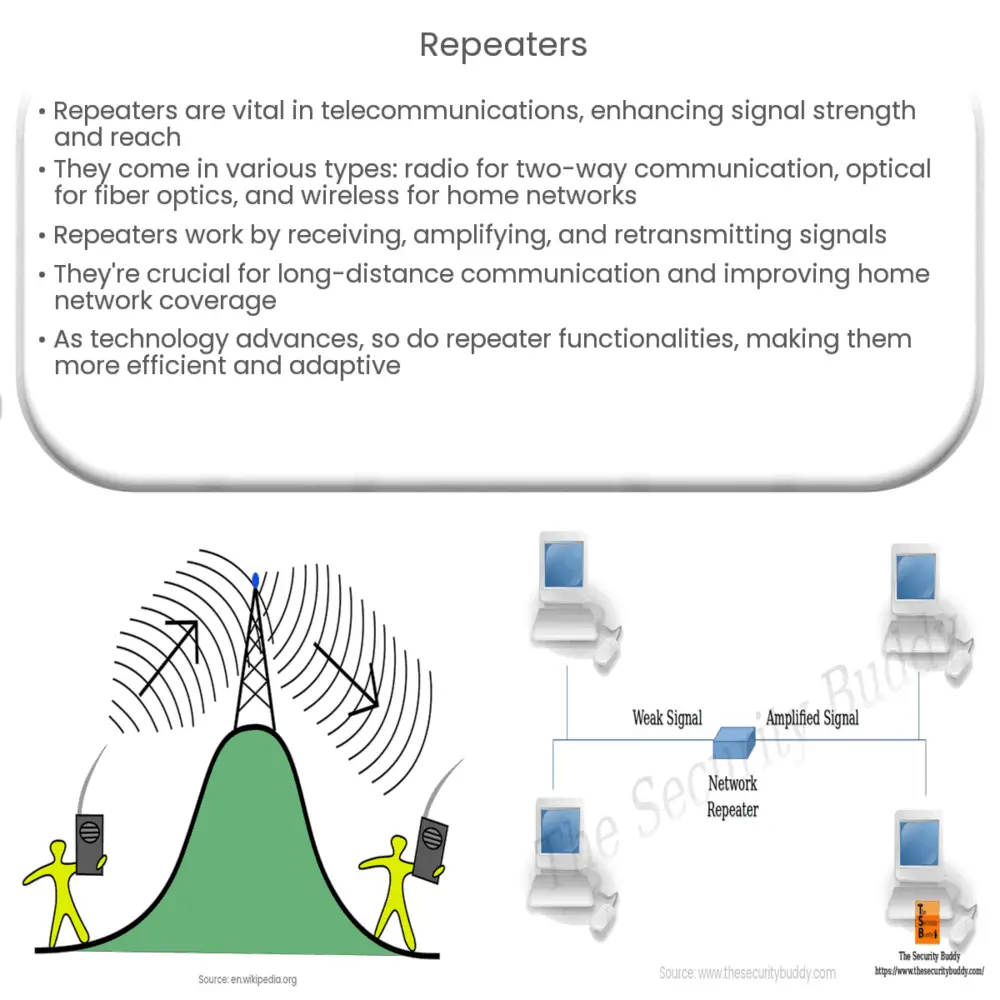Explore the role of repeaters in extending communication networks, their types, use cases, evolution, and future prospects.

Understanding Repeaters
A repeater is a piece of technology that plays a critical role in the field of telecommunications. Its main function is to extend the range and capability of communication networks, making it possible to send and receive data over larger distances. In simple terms, a repeater works by receiving a signal and retransmitting it, boosting its strength and reach.
Types of Repeaters
- Radio Repeaters: These are commonly used in professional, commercial, and government services. They facilitate two-way radio communication by extending the range between radios.
- Optical Repeaters: In the realm of optical fiber communications, these devices regenerate the light signal, maintaining the integrity and strength of the data transmission.
- Wireless Repeaters: Popular in home networking, these extend the coverage area of a wireless network by amplifying and rebroadcasting the WiFi signal.
The Working Mechanism of Repeaters
At a basic level, a repeater functions through a two-step process: receiving the signal and retransmitting it. The received signal is first amplified to restore its original strength and then immediately retransmitted to the next point on the network. This allows data to be sent across longer distances without degradation.
Use Cases of Repeaters
- Communication over large distances: Repeaters are often used in telecommunications and broadcasting to send signals over long distances, such as in the case of television and radio broadcasting.
- Improving home network connectivity: For home users, a WiFi repeater can help extend the range of a wireless network, making it possible to access the internet from farther corners of the house.
Despite their usefulness, it’s worth noting that excessive use of repeaters can lead to a phenomenon known as “repeater amplification,” where the signal’s noise level increases with each amplification, potentially disrupting the signal’s clarity and reliability. Understanding this limitation is critical when planning and implementing a network infrastructure.
The Evolution of Repeaters
The evolution of repeaters is closely tied to the evolution of communication technology itself. As communication technology has advanced, so too has the need for devices that can extend and enhance the range of communication. From telegraph lines of the 19th century to modern fiber-optic networks, the demand for reliable and efficient signal transmission remains, making repeaters as relevant today as they were when first introduced.[1]
Modern Repeaters and Technological Developments
Technological progress has brought about sophisticated variants of traditional repeaters, such as digital and intelligent repeaters. Digital repeaters don’t merely amplify the signal; they also correct errors introduced during transmission, ensuring cleaner and more accurate signal retransmission. Intelligent repeaters take this a step further. They can analyse the signal and automatically adjust their parameters to optimise retransmission, accounting for factors like interference and signal degradation. These developments have drastically improved the reliability and efficiency of modern communication networks.[2]
Application in Various Industries
Repeaters find application in numerous industries, from telecommunications to public safety, transportation, and more. In public safety, for instance, radio repeaters are used to extend the coverage of communication systems used by emergency responders. In the transport sector, they help facilitate reliable communication between control centers and moving vehicles. As the world becomes more interconnected, the role of repeaters in supporting seamless, continuous communication cannot be overstated.[3]
Future of Repeaters
The future of repeaters lies in the continued miniaturisation of electronic devices and the increased demands of communication networks. With the advent of technologies like 5G, IoT (Internet of Things), and further advancements in fiber optics, repeaters will need to evolve to keep pace. The repeaters of the future will likely be even more efficient, intelligent, and adaptive to the needs of an ever-evolving digital landscape.[4]
Conclusion
In conclusion, repeaters are a crucial component of modern communication systems, enabling reliable data transmission over long distances. They have evolved alongside the communication technology landscape, and their relevance and necessity continue to grow. From traditional to digital and intelligent repeaters, each iteration has been about improving the quality of communication and adapting to the increasing demands of our interconnected world. As we look to the future, the evolution and application of repeaters will undoubtedly remain at the forefront of communication technology advancements, serving as a testament to our continuous drive for better, more efficient ways of connecting with each other.



